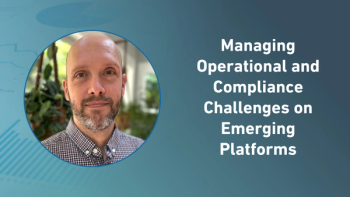
Revolutionizing Oncology: Insights on the FDA’s Project Optimus and Dose Optimization
Final guidance suggests sponsors select two doses for Phase II trials with additional data requirements.
As oncology drugs advance from cytotoxic chemotherapies to targeted treatments, newly finalized guidance from the FDA promotes early identification of optimal drug doses.1 Titled “Optimizing the Dosage of Human Prescription Drugs and Biological Products for the Treatment of Oncologic Diseases,” the guidance reaffirms the agency’s thinking about how sponsors should evaluate the balance between efficacy and toxicity in dose selection, starting in Phase I.
The final guidance—which was prepared by the FDA’s Oncology Center of Excellence (OCE), Center for Drug Evaluation and Research (CDER), and Center for Biologics Evaluation and Research (CBER)—has long been viewed as a codification of the OCE’s Project Optimus.2 Therefore, this article will:
- give a brief overview of Project Optimus, the final guidance, and the potential impacts of dose optimization.
- discuss the potential benefits and challenges posed by the final guidance.
- offer practical strategies for implementing the final guidance recommendations in clinical trials—including emerging trends and operational considerations.
Project Optimus: Background and purpose
Oncology studies traditionally are designed around a “more is better” philosophy that makes sense for chemotherapy drugs—rather blunt instruments that exhibit a linear dose-response and dose-toxicity relationship. Since administering more chemotherapy drugs typically results in greater efficacy but also increased toxicity, dose-finding oncology clinical trials have predominantly focused on identifying the maximum tolerated dose (MTD). Unlike studies for many other clinical indications, Phase II and Phase III studies of cancer drugs have historically evaluated few doses other than the MTD.
However, as oncology drugs become more precise and targeted, the directly proportional relationship between dose, clinical benefit, and toxicity doesn’t always apply. The “more is better” approach falls apart, as the maximum biological effect of newer antibody and small molecule therapies might be reached before the MTD—if an MTD is ever reached.3
Newer therapies are often given over longer periods of time than chemotherapies, as well. Therefore, patients must endure any side effects over many months or even years, rather than for the short, concentrated bursts of time typically associated with chemotherapies.
Given the evolution of oncology drugs, the FDA advocates for a similar evolution in clinical trial processes. Project Optimus encourages sponsors to identify doses that maximize oncology drug efficacy, safety, and tolerability in parallel. It asks sponsors to detect doses that allow patients to experience a sustained clinical benefit, emphasizing not just clinical benefit or tumor burden reduction, but also patients’ quality of life.
In essence, the final guidance recommends sponsors select two doses to take into Phase II trials—the MTD and a dose below it. Then, preferably through a randomized Phase II trial, they should determine which of the two doses is better. The overarching question becomes: From a safety and efficacy standpoint, is the lower dose as good as—or no worse than—the higher dose?
It is worth noting that the guidance does not address selecting the starting dose for first-in-human trials, nor does it specifically address dose optimization in the context of:
- radiopharmaceuticals
- cellular and gene therapy products
- oncolytic viruses
- microbiota
- cancer vaccines
- pediatric drug development
Still, the FDA states, “…some of the recommendations outlined may be applicable to these therapeutic modalities.”
The benefits and impact of dose optimization
Until now, Phase II doses often have been established without a substantial amount of dose-related data. One review of the tolerability of molecularly targeted agents in Phase III trials at doses and schedules recommended by Phase I trials identified that 48% of patients required dose modification.4
Likewise, it is not unusual to see dose reductions or discontinuations in drugs that have come to market without dose optimization. While patients’ tumors might shrink, the toxicity levels might be such that patients decide to discontinue treatments after one or two cycles because their bodies simply cannot tolerate them.
Project Optimus as outlined in the final guidance intends to help oncology drugs come to market at doses that are better tolerated by more people. The hope is that patients will be able to stay on their prescribed treatments longer, with fewer dose reductions—and thus improve outcomes.
Through this process, the characteristics of drugs may become better known, including better pharmacokinetic (PK) information and area under the curve (AUC) details. From a sponsor’s perspective, entering Phase II with a greater understanding of an effective dose may result in an easier path to market for a drug that ultimately is well-accepted by patients in a real-world setting. Moving work usually done at later stages into Phase I, and potentially reducing the need to re-work dosages, could also represent long-term savings for sponsors who plan to develop the drug beyond Phase I or Phase II. For sponsors that don’t plan further development, having an optimized dose may result in a more valuable product to sell onward.
Dose optimization implementation challenges
Despite its benefits, accommodating the FDA’s final guidance will create challenges for sponsor companies, especially smaller biotech firms. Based on experiences since the draft version of the guidance was released in January 2023, a Phase I study designed with Project Optimus in mind typically is slightly longer, more expensive, and operationally difficult because it requires additional patients and data.
Among the biggest issues posed by the final guidance is the need for further data in early development—especially clinical PK data, pharmacodynamic (PD) data, and biomarker data that shows biological effect.5 Too often, sponsors lack an adequate Phase I plan for gathering enough data to identify the biologically optimal dose and justify the Phase II dose. Therefore, they risk significant FDA feedback to their Investigational New Drug (IND) submission that could derail planned timelines.
Here is an example: One sponsor’s objective was to have their first patient dosed by the end of the year. They planned to submit their IND by September 1. However, it lacked details about how it would achieve the biologically optimal dose, giving the FDA a reason to deny approval. Although FDA clearance may take 30 days, making substantial updates to the protocol in response to major FDA feedback could take anywhere from four to eight weeks. In this situation, the corporate goal of getting the first patient dosed by the end of the year would have been missed.
The final guidance also presents patient—and hence site—enrollment challenges. In fact, some have worried that Project Optimus could inadvertently discourage cancer research in instances where patient enrollment already is particularly difficult, such as in rare disease and pediatric studies.6 In a nod to those concerns, the final guidance notes, “This guidance also does not specifically address pediatric drug development, for which there are unique considerations; however, some of the recommendations outlined may be applicable to dosage optimization for pediatric patients.”
Strategies and recommendations
The final guidance contends, “With sufficient planning, identifying an optimized dosage(s) can be aligned with the goal of expediting clinical development.” Evidence suggests this is true.
More clinical trial designs slated for both US and European regulatory review have started adapting to the theories behind Project Optimus since publication of the January 2023 draft guidance. Those that successfully achieve agency approval generally start accounting for dose optimization from the very beginning. Some strategies sponsors may find useful include:
Engage the FDA early. The final guidance actively encourages collaborative dialogue: “FDA recognizes that the best approach to determining the optimized dosage(s) for a specific drug development program depends upon a variety of factors… Sponsors are therefore strongly encouraged to discuss their plans for dosage optimization with FDA during formal meetings, including early in clinical development.”
So, take advantage of pre-IND meetings with the FDA. Ask what they would like to see. Early discussions with the FDA may be especially beneficial for sponsors conducting trials for rare disease and other indications known for patient enrollment challenges.
Get outside perspectives into the Phase I/Phase Ia protocol. In addition to leveraging key opinion leaders (KOLs) during protocol development, ask experts at Institutional Review Boards (IRBs), contract research organizations (CROs), or other organizations to review the synopsis or draft protocol. Get experienced feedback on the dose optimization plan. Connect with patient advocacy groups, too. A protocol may be beautifully grounded in theory and biostatistics but fail to address patients’ needs, in which case principal investigators (PIs) and study coordinators may reject it. As an added bonus, incorporating the patient voice into the protocol dovetails nicely with the FDA’s Project Pragmatica, which seeks to increase patient-centricity and reduce patient burden by bringing real-world standards of care into the clinical research setting.7
Use data to strengthen the site list. From an operational perspective, sponsors need to avoid the traditional Pareto principle (or 80/20 rule) that posits 20% of a study’s sites are responsible for 80% of the patient enrollment. That poses timeline problems. To speed up timelines, sponsors should instead use data to find sites of which at least 80% are enthusiastic, meet patient enrollment goals, enter data, etc. There is a lot of data available through technological and digital platforms (e.g., Global Data, Medidata AI) that can help sponsors, CROs, and others find sites proven to be successful with similar studies.
Prioritize pre-study site engagement. Using data to strengthen the site list does not negate the need to develop good relationships with sites. Sponsors that actively talk with sites as they develop their protocol generate momentum going into the trial; they tend to hit their patient enrollment goals faster and attract better-quality patients than sponsors that don’t prioritize pre-site engagement. The difference is stark. A good site alliance or sponsor/site relationship can make all the difference between a study topping a PI’s list, or just sitting in the pile.
Lean into emerging trends toward Bayesian designs such as the popular Bayesian Optimal Interval (BOIN) design.8 It’s possible that study designs will need to be more inherently adaptive than in the past, especially in Phase II. So, sponsors may want to get early design advice from a statistical point of view. Studies can be done using a standard 3+3 design, but Bayesian model-based designs, of which there are many “flavors,” may help sponsors arrive at the optimal dose more efficiently. Bayesian designs essentially provide a set of rules that dictates dose modification based on specified safety events, and they carry a lot of statistical weight. BOIN and the closely related Backfill BOIN designs work well for meeting Project Optimus goals because they afford flexibility, are computationally light, and enable swifter and more accurate decision-making.
Don’t dismiss the use of satellite locations. Some dose escalation trials are now lasting 12 to 18 months because of the need to enroll so many patients. Satellite locations can help enroll more patients in a shorter amount of time, so sponsors should revisit the idea. Although challenges still exist, sites themselves have solved many longstanding concerns about PI oversight, investigational product (IP) distribution, and monitoring. They have had to: research institutions are now expected to generate revenue. So, sites have developed standardized processes using central monitoring hubs, EHRs, and other technological solutions.
The future of oncology trials
Project Optimus as codified by the FDA’s final guidance is the undeniable direction in which oncology studies are moving. It will inevitably impact sponsors’ clinical program decisions. Therefore, the earlier sponsors think about how to operationalize the FDA’s recommendations, the better.
Statistics suggest cancer strikes one out of two men and one out of three women.9 Over the longer term, perhaps Project Optimus will contribute to improved outcomes and quality of life for these patients as they undergo treatment—whether during the later stages of a clinical trial or after the treatment goes to market. That is the hope, and it is a mission well worth pursuing.
About the authors:
Matt Cooper, PhD is an Executive Director and Therapeutic Strategy Lead, Oncology, at Worldwide Clinical Trials
Jim Eamma is an Executive Director and Therapeutic Strategy Lead, Oncology, at Worldwide Clinical Trials
References
- U.S. Food & Drug Administration. Guidance Document: Optimizing the Dosage of Human Prescription Drugs and Biological Products for the Treatment of Oncologic Diseases. August 2024.
https://www.fda.gov/regulatory-information/search-fda-guidance-documents/optimizing-dosage-human-prescription-drugs-and-biological-products-treatment-oncologic-diseases - U.S. Food & Drug Administration.Project Optimus: Reforming the dose optimization and dose selection paradigm in oncology. 5 Jan 2024.
https://www.fda.gov/about-fda/oncology-center-excellence/project-optimus - Goswami S and Rizzo J. Understanding Project Optimus. Applied Clinical Trials. 13 July 2022.
https://www.appliedclinicaltrialsonline.com/view/understanding-project-optimus - Roda D, Jimenez B, Banerji U. Are doses and schedules of small-molecule targeted anticancer drugs recommended by phase I studies realistic? Clin Cancer Res (2016) 22(9):2127–32. doi: 10.1158/1078-0432.CCR-15-1855.
https://pubmed.ncbi.nlm.nih.gov/26581244/ - Bullock J and Shetty K. FDA’s Project Optimus Guidance: Highlights and Tips for Success for Oncology Drug Developers. Applied Clinical Trials. 24 April 2023.
https://www.appliedclinicaltrialsonline.com/view/fda-s-project-optimus-guidance-highlights-and-tips-for-success-for-oncology-drug-developers - Kolb EA. A well-meaning FDA policy is a threat to pediatric cancer treatment. STAT. 4 Dec 2023.
https://www.statnews.com/2023/12/04/pediatric-cancer-treatment-fda-project-optimus-dose-optimization/ - U.S. Food & Drug Administration. Project Pragmatica: Advancing evidence generation for approved oncology medical products. 8 Feb 2024.
https://www.fda.gov/about-fda/oncology-center-excellence/project-pragmatica - Ananthakrishnan R, Lin R, He C, et al. An overview of the BOIN design and its current extensions for novel early-phase oncology trials. Contemporary Clinical Trials Communications (2022) 28(8):100943.
https://doi.org/10.1016/j.conctc.2022.100943 . - City of Hope. Women and cancer. 21 April 2022.
https://www.cancercenter.com/women-and-cancer
Newsletter
Stay current in clinical research with Applied Clinical Trials, providing expert insights, regulatory updates, and practical strategies for successful clinical trial design and execution.






.png)



.png)



.png)
.png)
